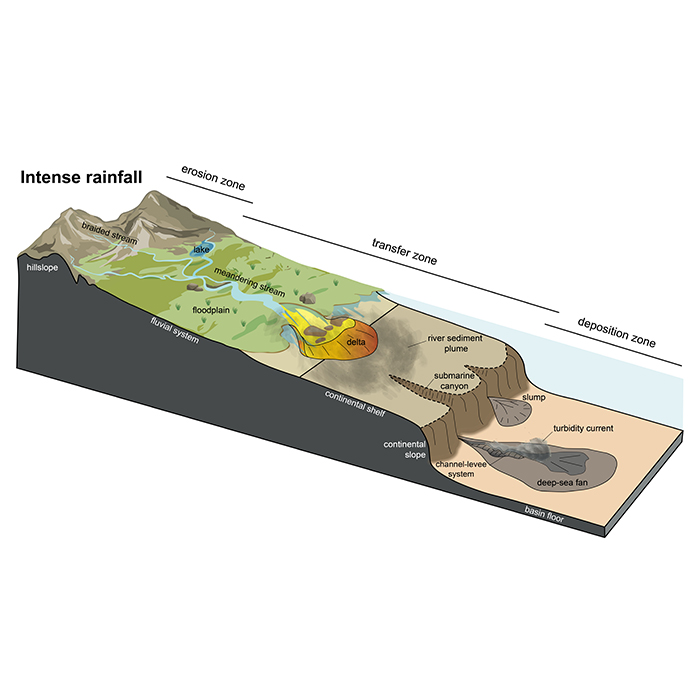56 million years ago, the Earth experienced one of the largest and most rapid climate warming events in its history: the Paleocene-Eocene Thermal Maximum (PETM), which has similarities to current and future warming. This episode saw global temperatures rise by 5-8°C. It was marked by an increase in the seasonality of rainfalls, which led to the movement of large quantities of clay into the ocean, making it uninhabitable for certain living species. This scenario could be repeated today. This is what a team from the University of Geneva (UNIGE) has revealed, thanks to the analysis of sediments taken from the deep waters of the Gulf of Mexico. These results can be found in the journal Geology.

Credit: © Lucas Vimpere
56 million years ago, the Earth experienced one of the largest and most rapid climate warming events in its history: the Paleocene-Eocene Thermal Maximum (PETM), which has similarities to current and future warming. This episode saw global temperatures rise by 5-8°C. It was marked by an increase in the seasonality of rainfalls, which led to the movement of large quantities of clay into the ocean, making it uninhabitable for certain living species. This scenario could be repeated today. This is what a team from the University of Geneva (UNIGE) has revealed, thanks to the analysis of sediments taken from the deep waters of the Gulf of Mexico. These results can be found in the journal Geology.
The Paleocene-Eocene Thermal Maximum (PETM), which occurred 56 million years ago, is the largest and most rapid climatic disturbance of the Cenozoic era (65.5 million years ago to the present day). Exceptional both in terms of its amplitude (5-8°C increase) and its suddenness (5,000 years, a very short time on a geological scale), this episode was marked by a warming of temperatures on a global scale. It lasted for about 200 000 years and led to numerous marine and terrestrial extinctions.
It would have been caused by a high concentration of carbon dioxide – the famous CO2 – and methane in the atmosphere, two powerful greenhouse gases. As is the case currently, these gases may have been released by several phenomena, certainly in combination: the release of methane hydrates trapped on the seabed, the sudden and significant melting of the permafrost, and the injection of magma into the organic sediments of the western edge of Norway. The origin of these processes is still under debate. The impact of a meteorite and/or the effects of intense volcanic activity in the depths of the North Atlantic could be responsible.
A geological ‘‘archive’’ of unprecedented quality
Because of the many similarities between the PETM and the current warming, the geological remains of this period are being closely studied by scientists. A team from the UNIGE is now reporting new elements. ‘‘The objective of our study was to investigate the influence of these climatic changes on sedimentary systems, i.e. on the processes of sediment formation and deposition, and to understand how these changes could have been transmitted from the atmosphere to the depths of the ocean,’’ explains Lucas Vimpere, a post-doctoral scholar at the Section of Earth and Environmental Sciences of the UNIGE’s Faculty of Science and first author of the study.
The researchers analysed sediments taken from more than 8km deep in the Gulf of Mexico. This basin acts as a giant ‘‘sink’’ into which material eroded and transported from the North American continent over millions of years is discharged. ‘‘For reasons of cost and infrastructure, the sediments used to study the PETM are generally taken from shallow marine or continental environments. Thanks to the collaboration of an oil company, we were able to obtain a sample of unprecedented quality, without any alteration’’, says the researcher. The 543-metre-long core contains a 180-metre-thick PETM sedimentary record, making it the most complete geological ‘‘archive’’ of this period in the world.
More clay on the ocean floor
The UNIGE scientists found that it was composed first of a large layer of clay and then of a layer of sand, a counter-intuitive result. ‘‘At the time of the PETM, we thought that there had been more precipitation, and therefore more erosion, and that large quantities of sand had then been transported first by the fluvial systems into the oceans. However, thanks to our sample, we were able to determine that it was the clays and not the sands that were transported in the first instance’’, explains Sébastien Castelltort, full professor at the Earth and Environmental Sciences Section of the UNIGE Faculty of Science, and last author of the study.
This established that the period was not marked by an increase in the annual rate of precipitation but by an increase in its seasonality and intensity. ‘‘This resulted in increased mobility of the river channels – the deepest areas of a river – which in turn transported large quantities of fluvial clays deposited on the adjacent alluvial plains to the ocean depths. We can now consider the presence of clay in deep basins as a marker of increased rainfall seasonality,’’ says Lucas Vimpere. The phenomenon has led to an increase in ocean turbidity that is harmful to marine life, especially corals.
‘‘The PETM is a potential analogue of current warming. As recent IPCC reports show, we are also now seeing an increase in the seasonality and intensity of rainfall. As our study shows, this is likely to destabilise sedimentary systems in the same way as during the PETM and with the same consequences for the oceans and living species,’’ explains Lucas Vimpere. These new data can now be integrated into modelling aimed at predicting the evolution and consequences of global warming.
Journal
Geology
DOI
10.1130/G50641.1
Method of Research
News article
Subject of Research
Not applicable
Article Title
Carbon isotope and biostratigraphic evidence for an expanded Paleocene–Eocene Thermal Maximum sedimentary record in the deep Gulf of Mexico
Article Publication Date
9-Feb-2023




